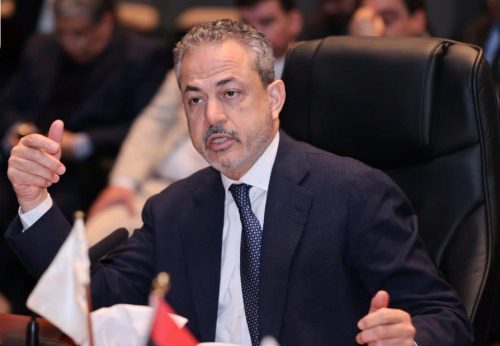Libya is preparing to launch a new licensing round for oil and gas in 2024, after a hiatus of more than 16 years due to the political and security upheavals that the country has suffered from.
The head of the National Oil Corporation, Farhat bin Qadrara, revealed during his participation this week in the “Sira Week” about his country’s plans to return to offering blocks for oil and gas exploration, to benefit from all its hydrocarbon resources, which are the main source of income.
The bidding round, if it happens, would be the first since 2007, and signals Libya’s return to business after more than a decade of political instability that has wiped out the lifeline outside the country’s exploration and production sector.
Libya has the largest oil and gas reserves in Africa, and its close proximity to Europe could make it one of the largest suppliers of energy to the continent.
Eni deal
Libya has already signed an $8 billion offshore gas project deal with Italy’s Eni this year that is set to produce around 760 million cubic feet per day of gas, boosting domestic production and exports.
The Libyan oil sector agreement with Eni faces several challenges, with many political factions rejecting it, according to data seen by the energy platform.
Libya recently signed a deal with the Italian company Eni to develop two gas blocks in the offshore area west of Tripoli. The deal aims to develop gas fields, whose reserves are close to 6 trillion cubic feet, within about 3 years, with an expected production of 850 million cubic feet per day for a period of 25 years.
Farhat Ben Gudara said the NOC was working with Eni to reduce gas flaring at offshore production facilities as part of a $1.2 billion project.
It is supposed to include the gas utilization project with a capacity of 85 million cubic feet per day, which aims to capture the flared gas in the Buri oil field, which has a capacity of 25 thousand barrels per day.
Return of investments to the oil sector
The head of the National Oil Corporation said: “We are coming for great potential.. We are applying for more investment in Libya, and the agreement with Eni is just a first step in a long road to more investment.”
Over the past 12 years, Libya has faced reluctance and withdrawal from major international energy companies, in light of security instability. This prompted the country’s oil production to collapse, and planned projects are still on hold.
The National Oil Corporation plans to increase production to 2 million barrels per day within 3 to 5 years, compared to its production of 1.13 million barrels per day, according to January estimates.
Libya remains politically fragmented, with loosely allied western and eastern factions vying for power.
The United Nations envoy to Libya, Abdullah Batili, outlined the country’s plan to hold elections this year, but internal discord and competing international interests present major obstacles.
drilling plans
The head of the National Oil Corporation confirmed that the upcoming exploration plans by Eni and BP after the two parties reached a long-delayed agreement late last year.
The deal includes 3 large blocks, two onshore in the Ghadames Basin and one offshore in the Sirte Basin, to be managed by Eni.

Benkedara said offshore drilling is targeted in 2024, Argos Media reports.
He added, “This is potentially a huge asset of gas for export to Europe, as Area C is likely to produce more than the Egyptian Zohr field, according to the geological and seismic studies we have conducted so far.”
Zohr field is the largest gas field in Egypt, with a current capacity of 2.6 billion cubic feet per day, which is equivalent to about 40% of Egypt’s total gas production of about 6.4 billion cubic feet per day.
Benkdara stressed that such large ambitions on the part of Libya would need to be backed up by large investments in infrastructure.
Last December, the National Unity Government, headed by Abdul Hamid al-Dabaiba, announced the lifting of force majeure on oil and gas exploration operations in Libya.
The Libyan National Unity Government has addressed the international companies working in the field of oil and gas in Libya, with which the National Oil Corporation has signed agreements to conduct research, exploration and exploration operations, that they can return to resume their work in the country.
Plans to increase gas exports
The head of the Libyan National Oil Corporation indicated the possibility of establishing a natural gas liquefaction station, as an alternative to the Libyan Marsa Al-Bariqa LNG facility, which has been suspended since the 2011 civil war.
The head of the National Oil Corporation also brought up the possibility of building a gas pipeline to Egypt for possible connection to the Idku station, which has a capacity of 7.2 million tons per year, and the Damietta station, which has a capacity of 5.5 million tons per year, which the state plans to expand in the coming years.
Despite Libya’s efforts to boost its gas export capacity, the country produces barely enough gas to feed itself.
Libya witnesses regular power outages at the height of the summer months due to the lack of fuel for power stations, as gas production currently stands at about 1.3 billion cubic feet per day.
Meeting domestic demand is the most pressing challenge in Libya, as gas exports through the 775 million cubic feet per day Green Stream pipeline – Libya’s only gas export outlet – are regularly restricted to meet domestic needs.
Over the past year, flows recorded their lowest levels since 2011, averaging 250 million cubic feet per day.
Flow volumes so far this year have risen slightly to 265 million cubic feet per day, according to data seen by the specialist energy platform.
related topics..
Also read..

Leave a Reply